Although electrical power cables are not the province of this site, they were sometimes made by the same manufacturers as communications cables.
Examples here of manufacturers which made both types are Siemens Brothers of London and W.T. Henley’s Telegraph Works Co. Ltd.
Johnson & Phillips were cableship equipment suppliers, and also offered “Telegraph, telephone
and insulated electric cable of all kinds”, but their power cable sample on this page is the only cable specimen of any kind that I have seen from them.
Other power cable makers shown here include British Insulated Cables and Callender's Cables, which merged in 1945 to form BICC (British Insulated Callender's Cables); Pirelli (which began making power cables in 1924); and the American firm Okonite.
I often see power cables described as “a section of the first Atlantic cable”. Many cable samples which have come down over several generations have an oral history attached to them, and this is sometimes wrong. The specimens on this page should clearly show the difference between cables designed to carry power (lots of copper) and telegraph/telephone signals (not so much).
Power cables vary widely in size, determined by the voltage and current they are designed to carry; the cables shown here range from 3.5cm (1.4") to 13cm (5") in overall diameter. Telegraph and telephone cables typically have one conductor (very occasionally several) of no more than 1/8" diameter and are generally between 2cm (¾") and 5cm (2") diameter overall.
The samples on this page are all shown to the same scale, and are arranged in order of increasing overall size. The age of the samples varies from the early 1900s to 1975; dates are noted where known.
| Click on each image for a larger view |
Communications Cables (for reference)
Note the small amount of copper compared
to the power cables which follow |

Single conductor telegraph cable
1861 Algeria-France
Armoured
|
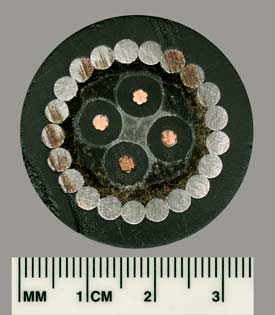
Simplex
Four conductor telephone cable
c. 1960
Armoured
|

Callender’s Cable
Two concentric conductors
Unarmoured |
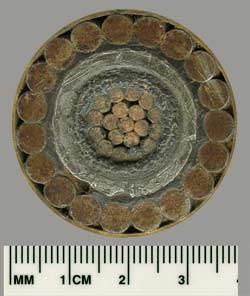
Unmarked
Single conductor, lead sheathed
Armoured, 19 wires |
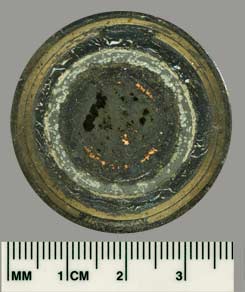
Siemens Brothers & Co Limited, London
Single conductor, lead sheathed,
outer spiral brass tape
.05 sq.in. 2,200 volts W.P. 1923
Unarmoured |

Messrs Johnson & Phillips Ltd. Charlton
.04 sq.in. 4-core, paper insulated, lead
covered,
steel tape armoured & served L.T. |

Callender’s Cable
Three conductors, lead sheathed
Unarmoured
|
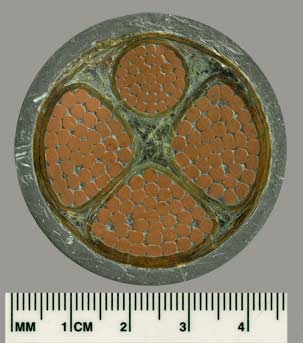
B I [British Insulated] with logo
Four conductors,lead sheathed
Unarmoured
|
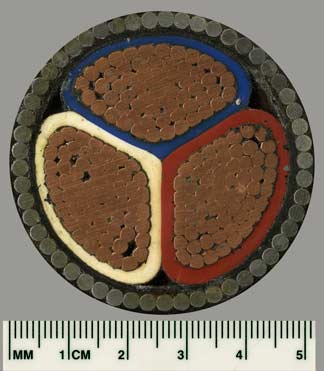
Henley Cable
W.T. Henley’s Telegraph Works Co. Ltd. London
3 x .4 sq.in. P.V.C. insulated textile
bedded S.W.A. and served L.T. cable
Armoured
|
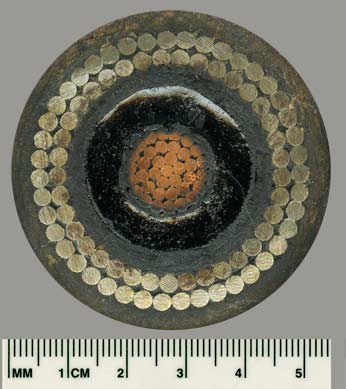
Callender’s Cable
Single conductor
Double armoured |
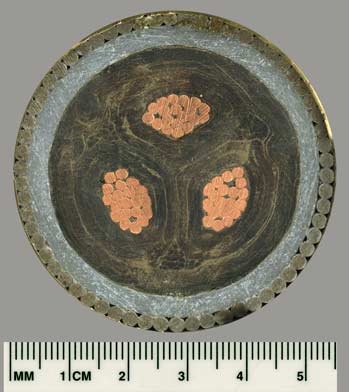
Callender’s
.075 three phase high tension trunk main
Lead sheathed
Armoured
|
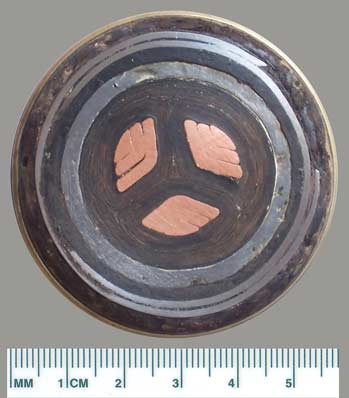
Henley E1135SA
Three conductor, lead sheathed
Double aluminum spiral wrap
The conductors are unusual, being formed
from
bent sheet copper rather than wire
Image courtesy of Gustavo Coll
|
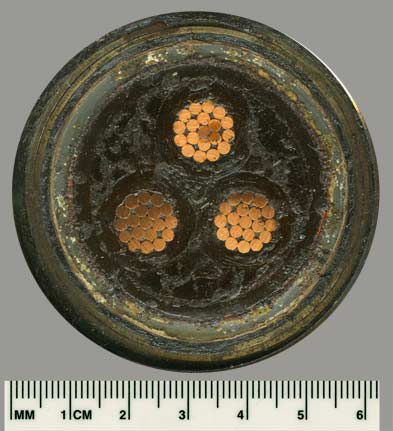
Siemens Brothers & Co Limited, London
Three conductors
33,000 volt cable
River Plate Electricity Co.
Laid – 1901
Lead sheathed
Unarmoured |
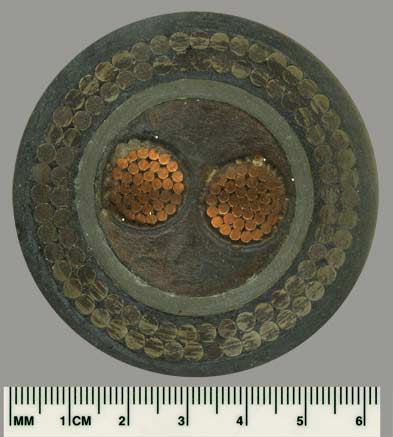
Henley’s London
Dover Dockyard, 1910
Two conductors, lead sheathed
Double armoured |
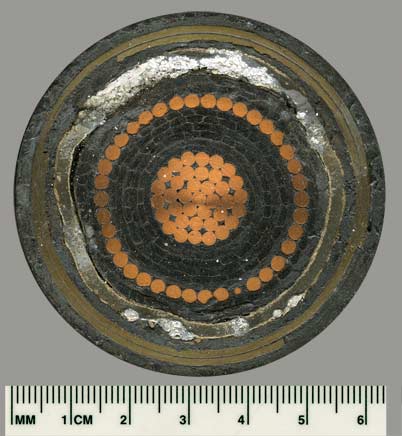
Siemens Brothers & Co Limited, London
Two concentric conductors, lead sheathed
Unarmoured
|
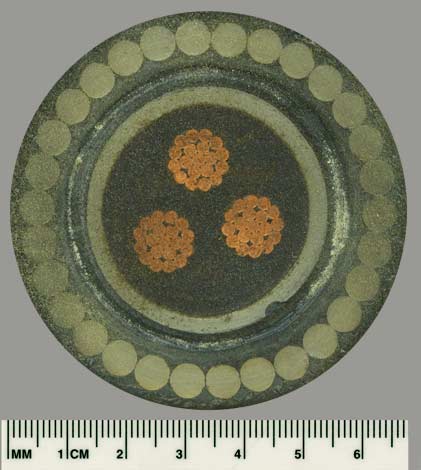
Manufactured and laid across the Cattewater (Plymouth)
Siemens Brothers & Co Limited, London
1 sq.in. 3 core 6.6 K.V. lead & rubber sheathed
wire armoured submarine cable |
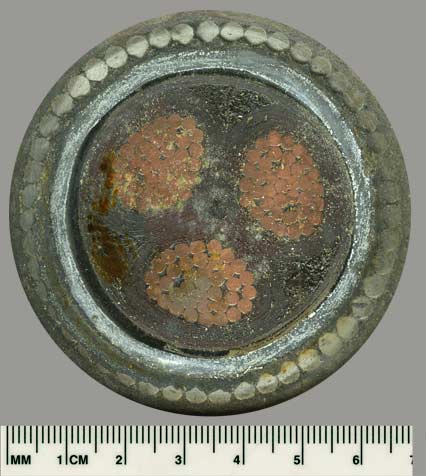
Watshams Cable Contractors,
Windsor House, Victoria Street, S.W.1.
Three conductors, lead sheathed
Armoured. |
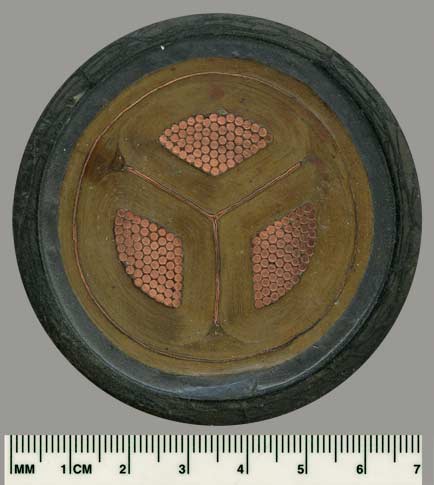
Pirelli General Cable Works Ltd. Southampton
3 x .15 sq.in. 11000 Vts
Unarmoured
|

Siemens Brothers & Co Limited, London
Section of cable below Medway from
Chatham Dockyard to Upnor Castle. Laid 1904
Three conductors
Double armoured |
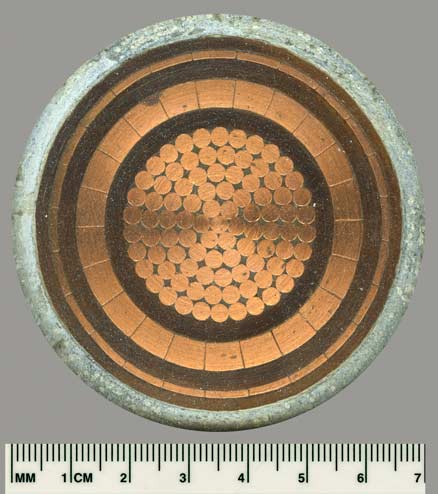
British Insulated Cables Ltd. Prescot, Lancs
1.0 sq.in. L.T.T. Conc: Class A
Three concentric conductors, lead sheathed
Unarmoured
|

Henley's made this cable for HMS Hood, the last battlecruiser
built for the Royal Navy, commissioned in 1920
Three conductors, lead sheathed, armoured
The sample is marked:
John Brown & Co. Ltd. Clydebank
.55 Sq. in 3 Core Ring Main Cable for H.M.S. Hood
W.T. Henley's
Telegraph Works Co. Ltd. London
HMS Hood had eight 200kW dynamos running
at 220 volts DC feeding thie ring main cablen
|

Edison-Sault Electric Co. installed this 138 KV submarine
cable in the Straits of Mackinac Summer 1975
1/C 500 MCM .690 x .790 hollow core, .505” paper,
lead, glass reinforced OPC, mylar tapes,
#6 BWG galv. steel armor wires. 138KV
Where’s there’s electrical power ... there’s Okonite Cable |
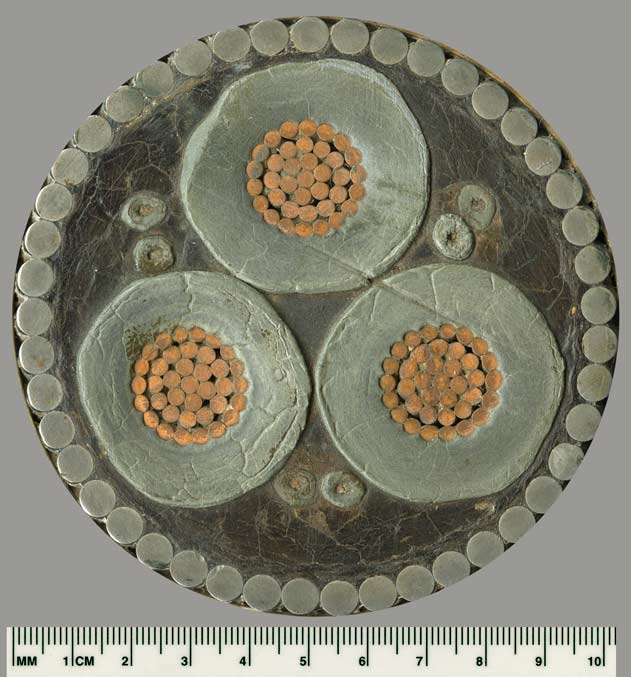
Unknown
Three conductors, lead sheathed
Armoured, 45 wires
The 4" long sample of this cable weighs over six pounds
|

Callender
3 core 132 K.V. impregnated pressure cable
Conductor 0.4 sq. ins. paper insulated,
lead sheathed, steel reinforced,
with one 2 core pilot and internal
gas communication pipe.
Laid for C.E.B. at Burford in 1943
Unarmoured
|
|

